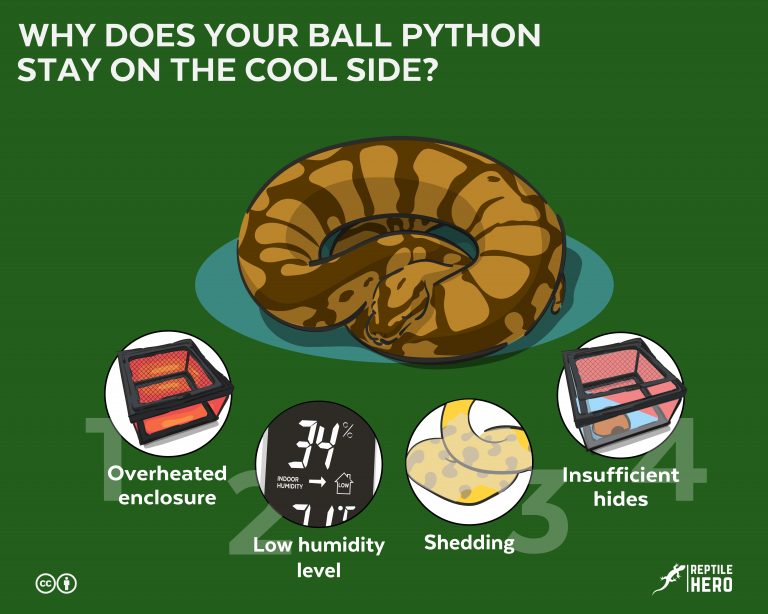Why Do Ball Pythons Smell Bad?
You’re probably planning on acquiring a ball python but are worried about their smell. Or are you a current keeper worried about the bad smell of your snake? If this happens, can you wash them like cats or dogs? More importantly, is it a sign of bad health for a ball python to stink?
Ball pythons normally do not smell bad, but their scent can be affected by their environment. If they make constant contact with their wastes or they have health issues, they can smell bad. Their smell will also vary depending on the cleanliness of a substrate, the amount of ventilation in the enclosure, and their level of stress.
Ball pythons are ectotherms meaning that they don’t sweat. So, why do some pythons smell bad? What are the ways to lessen a bad ball python smell? Can ball pythons musk? Find out the answers to all these questions as you read down below!
How Do Ball Pythons Smell?
In general, ball pythons smell neutral most of the time. However, their smell can also change depending on their environment since they don’t clean themselves up and can’t clean their own enclosure.
Odors that may linger on ball pythons include their wastes, soiled substrate, and feeder smell. They might smell bad due to their wastes and soiled substrate but this is normal especially if they made contact with it.
In rare cases, you can smell the urine of their last meal because feeders like mice and rats pee when constricted. But naturally, this won’t happen if you are feeding frozen-thawed or pre-killed feeders to your snake.
As pets, ball pythons smell less in comparison to cats and dogs. This is also due to the snake’s inability to sweat which lessens its natural odor. But if you keep a collection of ball pythons, then maybe you can smell their wastes especially if left uncleaned within a room.
From my experience and many other keepers, ball pythons have a low probability of stinking up your home—especially if you spot clean their enclosures regularly and replace their substrate when soiled.
I can assure you this because my 6-year-old ball python, Choco, is placed beside our dining area and we have not experienced any bad odor coming from him and his enclosure!
What Can Make a Ball Python and Its Enclosure Smell Bad?
In some cases, ball pythons and their enclosures will smell bad due to the following: 1) excreted matter, 2) soiled substrate, 3) low ventilation 4) defense mechanism, 5) illnesses.
So if your python is in tip-top shape and you keep its enclosure clean, you’ll likely never have issues will bad smells.
Nevertheless, it’s important for all keepers to understand what can cause ball-smelling pythons and enclosures!
1. Excreted Matter
The most common reason why a ball python will smell bad is due to the accumulation of its excreted matter. They release bodily wastes like feces, urates, and liquid pee more or less once a month.
Like most animals, a ball python’s excreted matter also smells bad due to the bacteria present in the digested waste. Its smell is comparable to the dung of a dog and other animals with a protein-based diet.
A ball python’s waste will cause the enclosure to smell, especially if it just got released or if it accumulates. In addition to this, the snake itself can smell poo or pee because it might’ve slithered to it or made contact.

If your ball python’s waste smells extremely bad or looks weird though, then it might be from bad food, parasitic infections, illnesses, or other factors.
>>Learn more about what a ball python poop should look like in our article does ball python poop smell?
2. Soiled Substrate
Ball pythons currently living on a soiled substrate will smell bad along with their enclosure. The substrate of a ball python can have liquid pee in it which might smell depending on the type of substrate.
When spot-cleaning, you might think that the solids are the only ones released by ball pythons. But they can also release liquid pee which might not be that obvious, especially if the substrate is naturally dark in color.
With light-colored substrates, like aspen and paper towels, it is easy to determine a wet spot made by a ball python, especially if checked regularly.
However, optimal substrates that are mostly used by keepers like cocopeat and cypress mulch will make it hard to determine a pee spot.
3. Low Ventilation
If the ball python’s enclosure has low ventilation, then the bad smell of their waste might be retained inside. With low air circulation, the waste would have a longer time of drying out which would not lessen the smell.
Ball pythons can thrive in environments with low oxygen and ventilation. This is observed in the wild with most specimens living in deep burrows.
This is generally observed by those using rack systems. You see, although ball pythons can live in a low-ventilated enclosure, the bad smell of their wastes will be retained inside which can also stress the ball python.
Interestingly, ball pythons know whether or not their environment is clean They are observed in the wild to leave burrows if their wastes pile up. They can also detect whether or not the water is safe to drink.
4. Defense Mechanism
In rare occurrences, ball pythons can produce musk, which smells bad, as a form of defensive mechanism against threats like predators. But in most cases, they will just pee as a sign of stress even during handling.
Musking refer to the defense mechanism of most snakes where they release a pungent and concentrated chemical from their cloaca that can deter away predators.
Ball pythons typically do not musk as this is not their primary method of defense. However, based on stories of other keepers, ball pythons can musk which smells really bad.
Keepers who have experienced this stated that they notice their ball python rubbing its tail on them which had a small amount of liquid that smells really bad. They describe a ball python’s musk as similar to a rotten egg which is a putrid-smelling scent.
5. Illnesses
Diseases and parasitic infestations can also cause a ball python to smell bad. This is primarily seen in the smell and condition of their wastes.
If you saw your snake pee blood or it smells horrid, then it might be a sign of an internal parasite. Common examples of python endoparasites are Coccidia, Strongylidas, and Ascaris [1, 2].
Another sign of either a respiratory disease or parasites is having a wet and putrid stool. However, this can also be a sign of dehydration to the snake. Consistent wet stools, on the other hand, are an alarming sign which needs immediate veterinary consultation.
You should be wary of consistent wet stools because it is a symptom of diseases like Cryptospridiosis (parasitic) and Nido virus (respiratory).
4 Ways to Prevent a Ball Python From Smelling Bad
To prevent ball pythons and their enclosures from smelling bad there are 4 ways: 1) optimal husbandry, 2) cross ventilation, 3) spot-cleaning, and 4) general cleaning.
1. Optimal Husbandry
Providing up-to-date husbandry will prevent illnesses and dehydration to a ball python which will, in turn, also lessen the chance of them smelling bad. Parameters like temperature and humidity are the main factors to evaluate.
As stated earlier, ball pythons that are dehydrated, have parasitic infections, or have diseases can smell really bad. The only way to prevent this is to have optimal husbandry summarized in the table below:
| Husbandry Parameter | Recommended Value |
| Temperature | 75–80°F for the cold side80–85°F for the warm side88–90°F for the hot/basking spot |
| Humidity | 60–70% ambient humidity80% during shedding or inside the humid hide |
| Security | At least 2 hides for the cold and hot side, additional decors and clutter for enrichment |
| Enclosure Size | 4x2x2 ft for adult ball pythons |
Proper humidity and temperature levels can prevent respiratory diseases and dehydration. Meanwhile, parasitic infestations can be prevented by keeping a newly acquired reptile in a quarantine enclosure for 2–3 months.
In addition to the table above, feeders must also be in great condition, especially frozen ones. A rotten frozen-thawed feeder will cause bad-smelling poop for the ball python.
>>Learn more about the best feeders for a ball python in our article about feeding mice and rats to a ball python
2. Cross Ventilation
Providing ample cross ventilation can lessen and prevent the bad smell coming from ball python wastes. This will allow the air to circulate and will dry out the wastes of the snake which lessens its smell.
Most screen-top tanks will do but providing side ventilation can also help with air circulation. This is also one of the best ways to reduce the smell inside the tank of a ball python.
But remember that with more ventilation comes the price of having lower humidity.
In this scenario, I recommend using foggers or modified humidifiers to increase the humidity inside the enclosure.
>>Learn more about methods to maintain humidity in our article can you use foggers/misters for a ball python?
Personally, I have both a screen top and side ventilation holes in my enclosure, since it is very humid in my area. On the bright side, I do not have humidity problems for my ball python.
3. Spot-Cleaning
Regular spot-cleaning can prevent a ball python and its enclosure from smelling bad. Spot-cleaning is the method of manually picking up solid wastes the snake has left.
To spot clean efficiently, I recommend picking up the solid wastes along with the substrate underneath and near them. This is done because there are times when a ball python will release solid and liquid wastes at the same time.
However, if you see a wet spot far away from the water dish, then it is most likely where your ball python peed and I suggest removing it.
Pro Tip: Along with spot cleaning, replacing the water in the dish at least 1–2 times a week or once it’s empty is recommended to provide the ball python regular access to clean water.
There are times when the ball python will pee on its water dish too. In such cases, they won’t drink from it so they can get dehydrated unless it’s immediately replaced with clean water.
4. General Cleaning
General cleaning is the best way to prevent the bad smell of the ball python and its enclosure. This must be done once every 1–2 months or once the bad smell inside the enclosure becomes really strong.
Here are some important tips for cleaning a ball python enclosure thoroughly:
- Substrate Replacement. Replacing the substrate is a must due to possible nitrate build-up in it which both smells bad and is unsanitary for the snake.
- Clean All Items. Thorough cleaning of the hides, water bowl, and other ornaments inside the enclosure is also done. Some bad smells can stick to these items and might be the cause of the bad scent you smell.
- Disinfect Properly. You can wash the whole enclosure with dish soap and a sponge. But if it is too heavy, you can spray it down with a veterinary-grade disinfectant.
- Let Everything Dry. Be sure to wipe the whole enclosure dry and observe for any strong smells before putting the ball python back in. Strong smells can cause stress to a ball python.
I usually change Choco’s substrate every 1½ months. I use aspen shavings which is a great substrate for those living in a humid area.
Pro Tip: Cocopeat and cypress mulch are great substrates for a ball python. They absorb liquid well and can lessen the smell of pee inside the enclosure.
Paper towels, newspapers, and reptile mats are the worst substrates for lessening bad smells in a ball python enclosure. Although they are somewhat moisture-absorbent they also hold odors well—which is not ideal if you want a clean-smelling snake tank.
Can You Wash Your Ball Python to Remove the Bad Smell?
It is not advisable to wash ball pythons to get rid of bad smells because it causes unnecessary stress. Bathing pythons and other snakes should only be done under the recommendation of an experienced exotic veterinarian.
Ball pythons do not need to be washed regularly like other pets like dogs.
If the ball python itself smells really bad even after thorough cleaning of the enclosure, then it can be an exception for a bath.
Such a bath is done to sanitize the snake itself which can prevent infections and other bacterial-related implications. More importantly, this is typically done using a lukewarm solution of highly diluted povidone-iodine water.
But keep in mind that most ball pythons find assisted bathing to be stressful which means that it should only be done when needed.
Soaking a snake for your leisure is highly discouraged.
>>Learn more about assisted soakings in our article how long can a ball python last underwater?
Further Questions
Do ball pythons smell with their tongue?
Ball pythons, like most snakes, grab chemicals in the air using their tongue. This is can be described as “tasting the air” which assists them during hunting and navigating their environment. To smell, they use an organ located on the roof of their mouth called the Jacobson organ.
Can ball pythons clean themselves?
Unlike cats, ball pythons cannot clean effectively themselves when they feel dirty. But in relation to this, they can choose to soak in their water dish when they are about to shed, have mites, or for temperature regulation.
Are ball pythons slimy and gross?
Ball pythons do not feel slimy and gross. In truth, snakes have very smooth scales that feel nice to touch. A snake’s scale is made up of keratin which is similar to the outer layer of a human’s teeth.
Summary of Do Ball Pythons Smell Bad
In general, ball pythons do not smell bad. However, their smell will vary depending on factors like excreted matter, soiled substrate, illnesses, low ventilation, and defense mechanisms.
There are many ways to prevent a ball python from smelling bad, namely: providing optimal husbandry, cross ventilation, regular spot cleaning, and thorough cleaning of the entire enclosure.
Giving a ball python an assisted bath is only done as a last resort if their bad smell would not go away after thorough cleaning of their enclosure. Giving a bath to ball pythons for leisure and other minor reasons is highly discouraged.
Sources
[1] https://actavetscand.biomedcentral.com/track/pdf/10.1186/1751-0147-53-33.pdf
[3] https://www.researchgate.net/publication/31442824_Blood_Oxygen_Transport_and_Delivery_in_Reptiles







